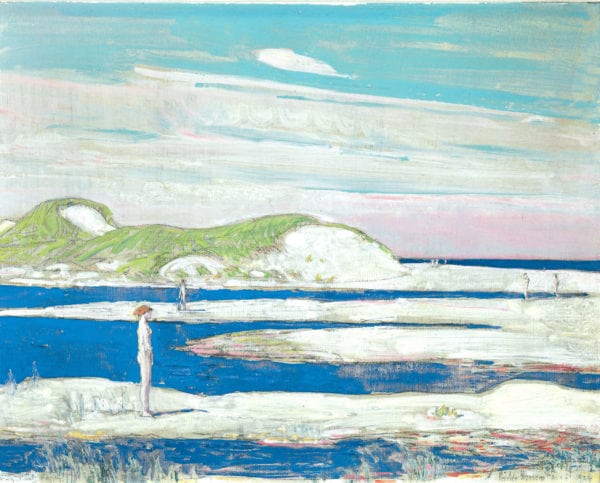Flying Point Beach, Watermill, 1924
Childe HassamOil on board
6 1⁄8 × 7 3⁄4 inches
Signed and dated (lower right): Childe Hassam 1924
Inscribed (lower left): Flying Point Beach
Provenance
Private collection, New York
Childe Hassam often spent his summers away from New York City, working and enjoying the outdoor life at the shore or in the country. He visited East Hampton for the first time in 1898, when the Spanish-American War prevented him from traveling to his beloved Isles of Shoals (a group of islands, a significant distance off the coast of New England). From then on, Hassam returned to the South Fork of Long Island almost every year, ultimately buying an eighteenth-century house on Egypt Lane, in 1919.
Inspired by the flat, yet fertile, terrain, changing light and water, local buildings and gardens, Hassam’s East Hampton pictures run the gamut of his typical themes of landscapes, portraits, and local vignettes. In many ways, Hassam’s Flying Point Beach looks much as it does today with sand bars emerging in low tide from Mecox Bay, large dunes rising on the left and the ocean visible in the background on the right. Beachgoers stroll in the distance, and one figure in mid-ground appears to test the water with his foot. Yet, the stationary nude in the foreground, fixedly staring out to sea, imbues the scene with a meditative and mysterious quality. Indeed, all the figures seem surprisingly nude. By around 1920, the artist was setting small figures into some of his landscape scenes, ranging from Biblical figures to idealized and enigmatic nudes as seen here, as well as golfers at the Maidstone Club course. Punctuating the primarily horizontal composition, the vertical thrust of the figures anchor the image and demonstrate the artist’s sophisticated understanding of spatial relationships.
Hassam employed countless fine brushstrokes in an inspired array of colors in order to develop the emotional tenor further. Luminous large areas of pink in the sky, acid green covering the dunes, and deep blues in the bay and the ocean, combine with the small shots of bright reds and greens at the shoreline to enhance the dramatic and ethereal mood. By combining these contrasting colors with the ghostly whites and grays of the sand, Hassam created an image that is ruminative and enigmatic. In this way, Flying Point Beach is reminiscent of Symbolist works by artists such as Thomas Wilmer Dewing and Arthur B. Davies.
Literature
- This painting will be included in Stuart P. Feld’s and Kathleen M. Burnside’s forthcoming catalogue raisonné of the artist’s work.

